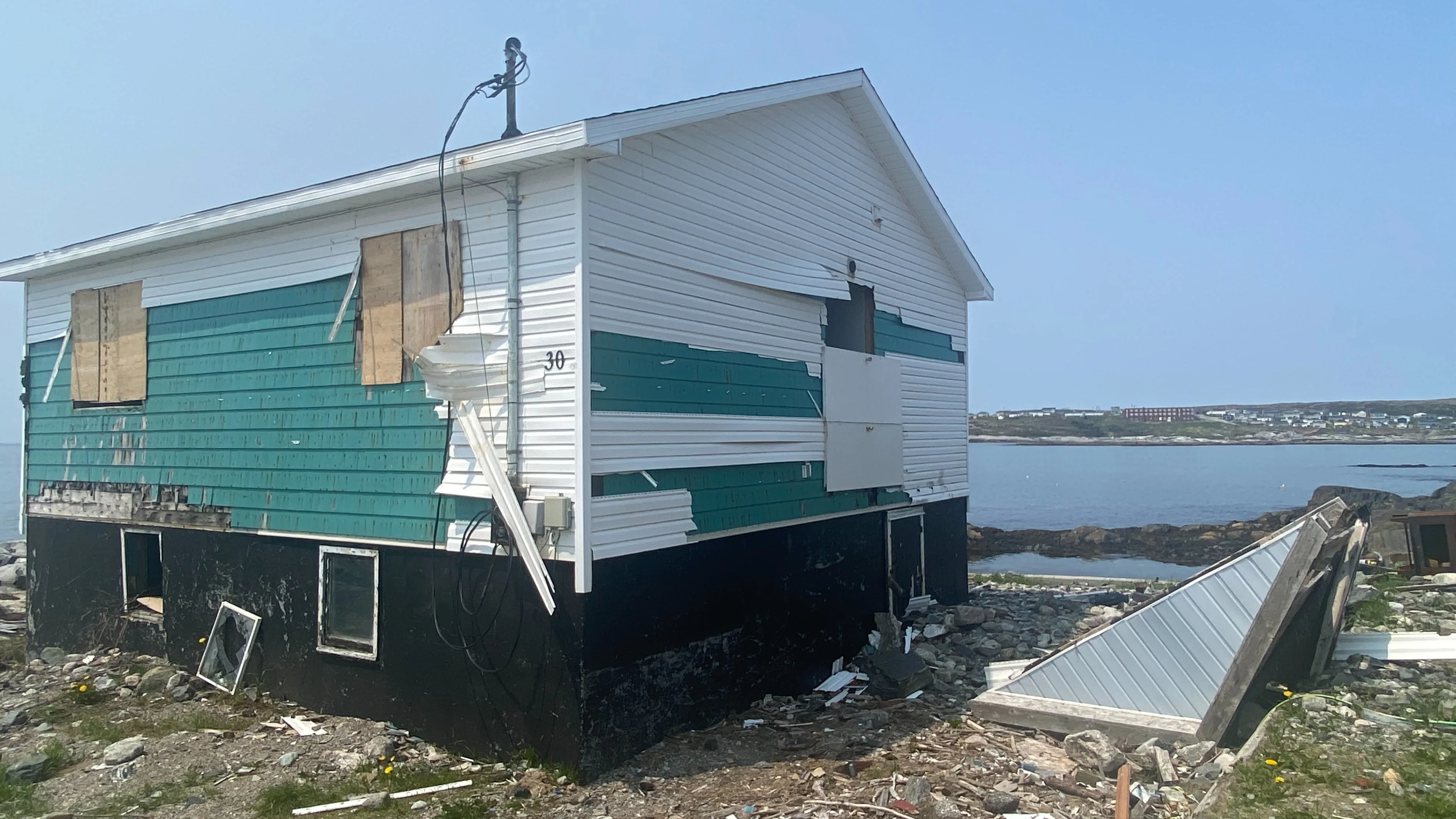
Post-Fiona rebuild continues with climate crisis in mind in Newfoundland
The Weather Network met with many locals and area officials in Port Aux Basques, Nfld., to hear some untold stories from Fiona and how the rebuild is progressing.
Returning to Port Aux Basques nearly a year after Hurricane Fiona damaged dozens of homes and displaced hundreds of residents was a surreal experience.
Many condemned homes in the small town on the southwestern coast of Newfoundland have been torn down and debris from the ones swept out to sea in an instant now tidied.
The Weather Network met with many locals and area officials to hear some of the untold stories from that harrowing storm in September 2022, and find out how the rebuild is progressing. While there was a spirit of tenacity, many are concerned about the impacts of climate change, and planning for a future with increasingly severe storms.

Kerbie Seaward surveys the shoreline in Port Aux Basques, Nfld., where Fiona's storm surge hit near her home. (Nathan Coleman/The Weather Network)
Hurricane Fiona’s unimaginable wave
The pain of that day back in September is still plainly evident on Kerbie Seaward's gaze. She lives on Clement Crescent, which was hard hit by the storm surge. She shared a never before scene video of the waves as they arrived in her backyard.
"I haven't listened to myself in this video since it was taken," she told The Weather Network as the video played.
The images were harrowing: as the waves only get worse, property begins to disappear. It was at that point during the storm that Seaward realized she needed to flee.
"We have so many storms here that nobody took it seriously," she explained.
Just four houses down, Norm Hinks and his partner, Thelma Leamon, were watching as the waves got ever closer.
"We saw this big wave coming and it kept rolling and rolling and it hit my neighbor's house and turned it on the foundation,” Hinks told The Weather Network. “It took my shed and my boat and flattened it and pushed it all with the tide, it took my two sheds, two boats, ATV, my basement and my wife — all one wave."

Norm Hinks and Thelma Leamon. (Handout)
Leamon was the only person in Newfoundland and Labrador to lose their life in the storm. Her body was recovered, but a life ring still floats untouched in the cove where she was last seen, a sort of unofficial memorial.
Once an avid hunter, Hinks now spends his days watching television and says he'll never live near the water again. He's still waiting for government compensation for his losses.
Andrew Parsons, Newfoundland’s minister of Industry, Energy and Technology, put the damages into perspective standing on the shore looking out at the small island that protected the community and roads from storm surge — a barrier that was overwhelmed by waves during Fiona.
“When this is all said and done we're getting close to $100 million in terms of cleanup and repair and putting people back in new homes. I mean, we're upwards of 150 homes that are either gone outright or are placed in a situation where they're not safe just due to the land erosion,” Parsons told The Weather Network.
"It's sad to say that a life was lost. But I think a lot more lives could have been lost if it happened at 2-3 a.m. instead of 5-6 a.m.," said Seaward.
The storm surge was a wake up call to many who won't soon underestimate the power of an incoming storm in the era of climate change in Newfoundland.
Watch below: Aftermath of hurricane Fiona still felt on Burnt Islands
A community cut off by Fiona braces for the future
Coun. Wallace Kinslow's house stood sturdy for 88 years near the water in the small community of Burnt Islands in Newfoundland and Labrador, but it was condemned and torn down after the devastating impacts of Hurricane Fiona
"We used to get foam — like the water come in and spray at the house — but I never witnessed anything like that in my life," he told The Weather Network when we visited the area to meet with many locals and officials to hear some of the untold stories from that harrowing storm last September.
The causeway to the island was flooded out during the storm, but has since been replaced. Out of 216 houses, 11 were lost in a community where 86 per cent of people living here are seniors.
The island itself may need to be evacuated during future storms to prevent residents from being stranded if the causeway gets taken down again.
"It's come to the point now where people are nervous. And they are seeing changes. And they are seeing major changes when it comes to the weather. Our weather patterns are different," said Port Aux Basques Mayor Brian Button.
"Hopefully this don't happen no more, but who can tell? By the way this climate change is going now, this could happen anytime. And if we clean out any more of these homes, all it takes is another 12-15 homes here, this community is gone," said Wallace Kinslow, a councillor in Burnt Islands.
Watch below: Newfoundland community leaders plan for future climate
Community leaders talk climate change as Fiona rebuild continues
Mayor Button says the damage caused to his community during Hurricane Fiona is forcing residents to rethink how close they live to the water in this coastal Newfoundland community. Area MLA Andrew Parsons is hearing the same thing.
"It's the first time ever I think that there's still a sense of fear. People who've lived next to the water their entire lives don't want to be there any more," Parsons told The Weather Network.
Button says winters in Newfoundland are also different now.
"We always had large amounts of snow here,” he said. “We have a lot of residents in our community now that live along the coastline that live on the edge. And they wonder with the smallest storms now, what's this going to be?”

Port Aux Basques Mayor Brian Button providing updates on the post-Fiona rebuild. (Nathan Coleman/The Weather Network)
Even the fishermen have noticed a change, and it affects their hauls.
“We have seen more lobsters over the winter. The climate is warmer, the salt water is getting warm. We're getting lobster now that if you haul up a cart at one time you get one or two but you're hauling up a cart with eight or 10 lobsters in it,” Kinslow tells the Weather Network.
Back in 2022, Clearwater Seafoods founder John Risley told the Ocean Frontier Institute conference, if he was going to look at his crystal ball, he'd say that the future of the lobster industry in Atlantic Canada is probably more in Newfoundland. Why? Just simply because as climate change moves through the ocean ecosystem and water warms up, species move with water temperatures.
But when it comes to storms, no one had ever seen anything like the storm surge brought on by Fiona.
"Is it climate change? A lot of us believe that it is. There are those that believe we're all talking nonsense when it comes to climate change but I don't believe that to be the case. I believe that our climate is changing,” said Button.
“And I'd say to people who don't believe it, come sit in our communities and talk to folks here, they've never seen anything like it.”
Thumbnail image: Home destroyed by Hurricane Fiona in the Port Aux Basques area of Newfoundland. (Nathan Coleman/The Weather Network)

